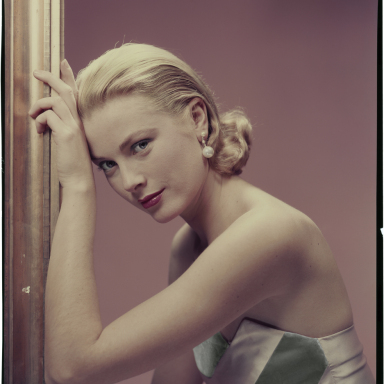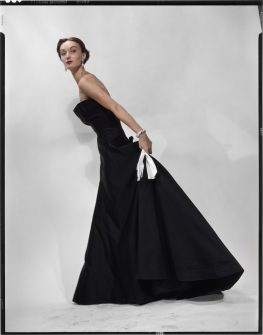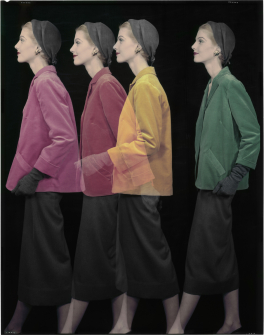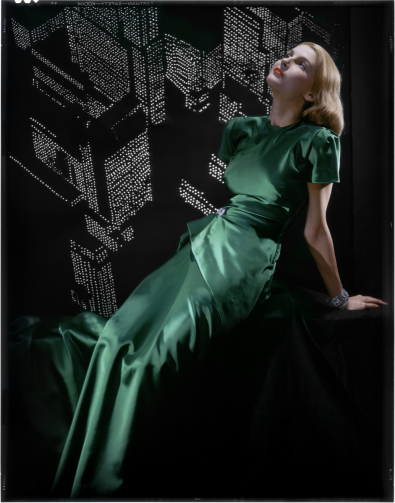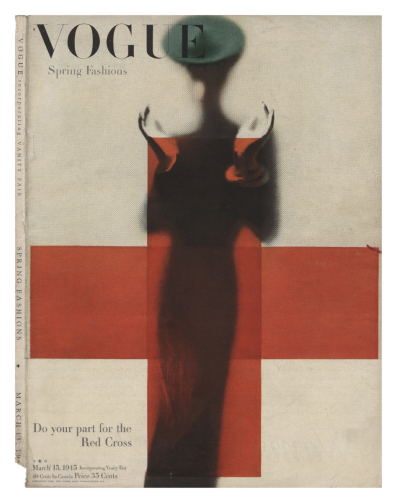Blumenfeld Studio: New York, 1941 – 1960 looks at one of the most influential photographers of the twentieth century, Erwin Blumenfeld and his latter works from his career in New York. Having produced an extensive body of work throughout his thirty-five year career, it was in the USA, after the war in the context of economic growth and a buoyant and expanding press, that Blumenfeld’s humorous, inventive and personal work flourished. This exhibition celebrates the output of his Central Park studio during the Second World War and post-war boom years, including fashion photography, advertising campaigns, personality portraits, ‘war effort’ propaganda posters and experimental work, which have since been recognised as significant technical achievements in the field. It features over ninety original modern prints, fully restored in colour, original publication clippings and rarely-seen fashion films from the early 60s.
After fleeing occupied France in 1941 to settle in New York, the German-born photographer was immediately signed up by Harper’s Bazaar, collaborating with Carmel Snow and Diana Vreeland on the magazine’s fashion shoots. After only three years of working in the USA, he had become one of the most famous and highly paid photographers in the business, with the New York Times heralding him as an “outstanding leader in imaginative photography”.
A highlight of his career in America was his 15 year collaboration with Vogue and Alexander Liberman, shooting over fifty US Vogue covers including portraits of famous models and high society women from the time; Babe Paley, Dovima, Jean Patchett and Carmen Dell’Orefice. He also regularly worked with other American fashion magazines such as Cosmopolitan (for which he shot Grace Kelly in 1955) and Life Magazine, as well as producing major advertising campaigns for fashion and beauty clients including Dior, Elizabeth Arden, Max Factor, L’Oréal and Helena Rubenstein.
Highly inventive and often opposing conventional codes, Blumenfeld developed his own idiosyncratic style, using photomontage, solarisation, colour slides and a host of hybrid techniques. From the start of his career, he was very much influenced by the idea of photography as art, wishing to be respected as an avant-garde artist rather than a fashion photographer. Embracing his creativity by “smuggling art” into his commercial projects, Blumenfeld frequently drew inspiration from art history and his interest in graphics, for example he took a modern twist on Vermeer’s Girl with a pearl earring for US Vogue and was inspired by Manet’s Bar des Folies Bergères for a Harper’s Bazaar shoot in 1941.
The exhibition is curated by Nadia Blumenfeld Charbit, François Cheval and Ute Eskildsen and was originally conceived for the Musée Nicéphore Niépce in Chalon-sur-Saône, France.
Erwin Blumenfeld
Erwin Blumenfeld was born in 1897 in Berlin into a Jewish bourgeois family. After his father’s death he entered an apprenticeship in the garment industry and then served as a soldier in France in the First World War, In 1918 he left to Holland and married Lena Citroen, opening a leather goods shop in Amsterdam in 1923 whilst also trying to become a painter. During the early twenties he participated in the Dada movement as a self-proclaimed head of the Dutch Dada movement, under the pseudonym of Jan Bloomfield. He began experimenting with photography in the early thirties, taking photographs of customers in his shop and later exhibiting his works at the Van Lier gallery in Amsterdam. When his business went bankrupt, he left for Paris in 1935 where he was introduced to the world of fashion photography and to French Vogue magazine, thanks to Cecil Beaton who admired his photographs. During World War II, Blumenfeld was interned in French war camps but managed to escape to the US with his family in 1941 through Marseilles. In New York where he was offered a contract by Harper’s Bazaar and after three years began freelance work for Vogue US. Within a few years he had become one of the most famous color fashion photographers in the US. He continued to work in fashion and advertising until the early sixties, when he devoted his time to writing his autobiography ‘Eye to I’. He died in Rome in 1969.
Venue: Somerset House, East Wing Galleries, East Wings, Strand London WC2R 1LA
Open: 23rd May - 1st September 2013
For more information please visit: www.somersethouse.org.uk/

